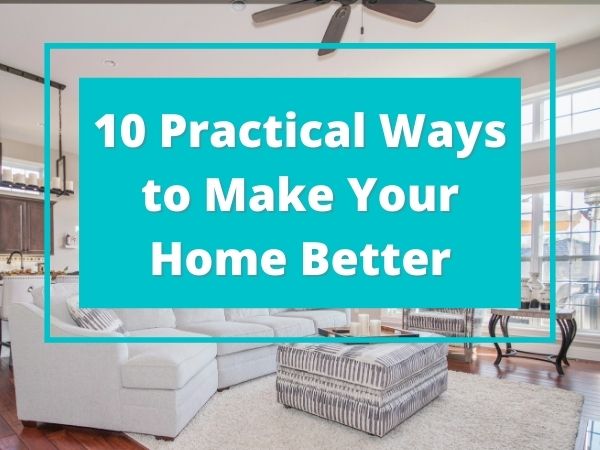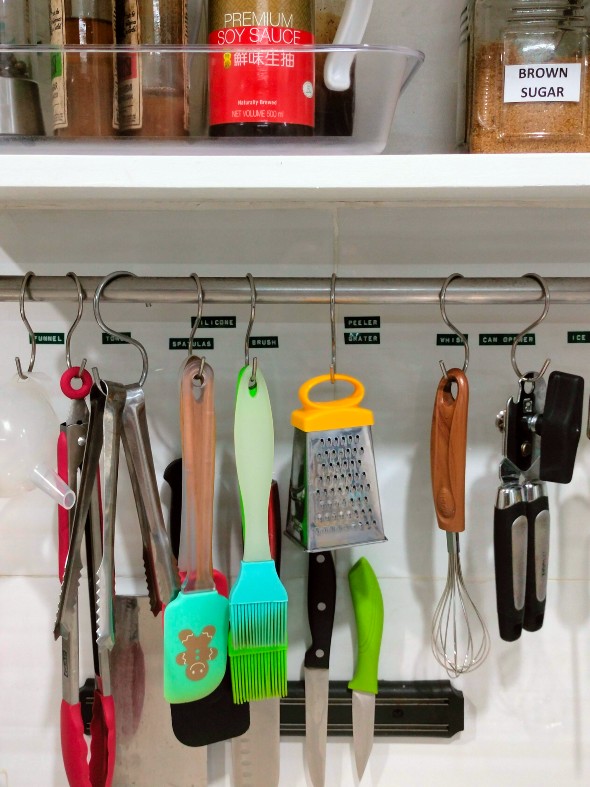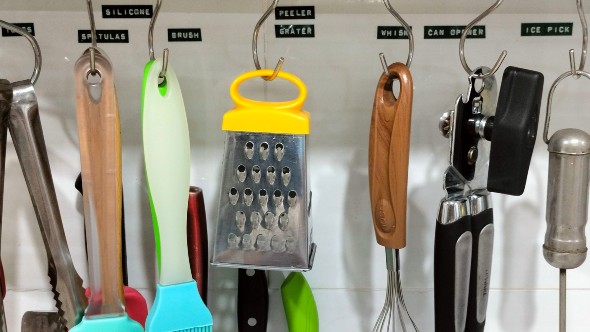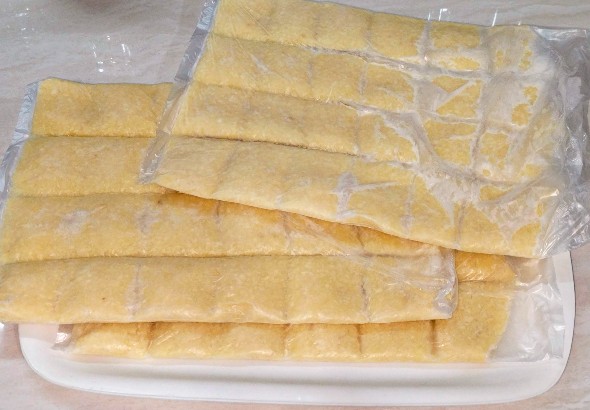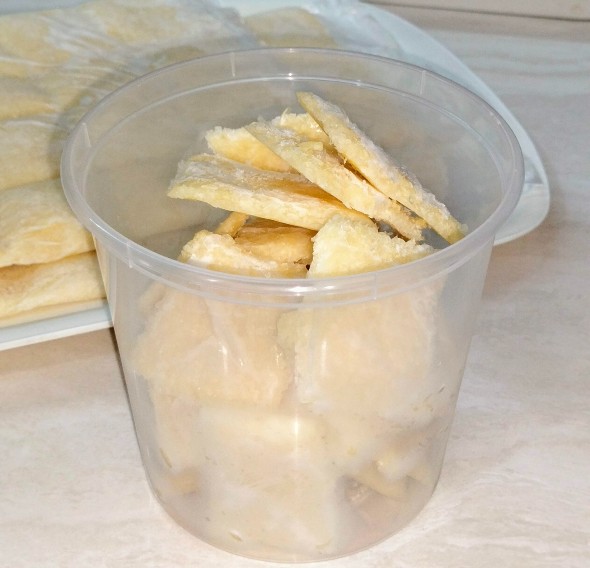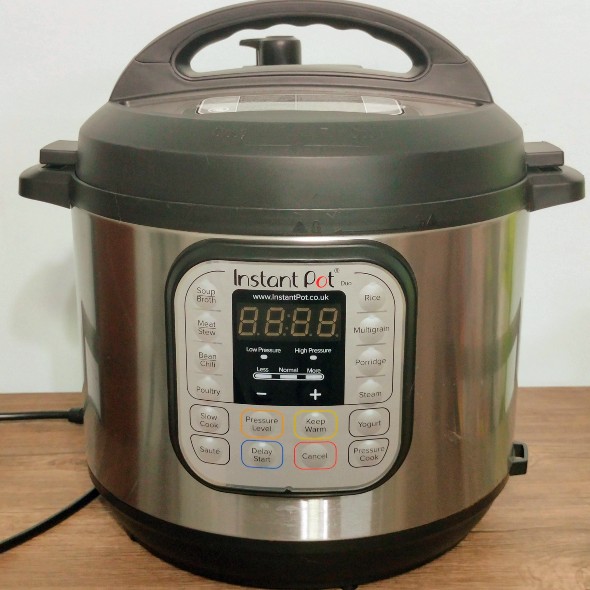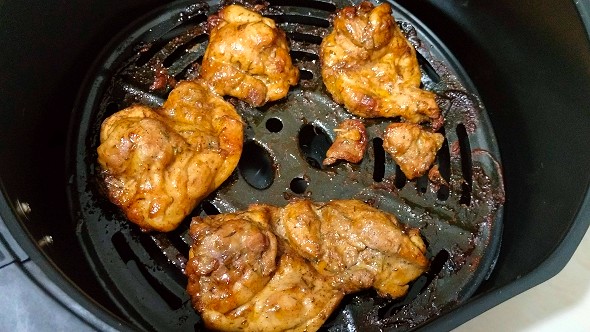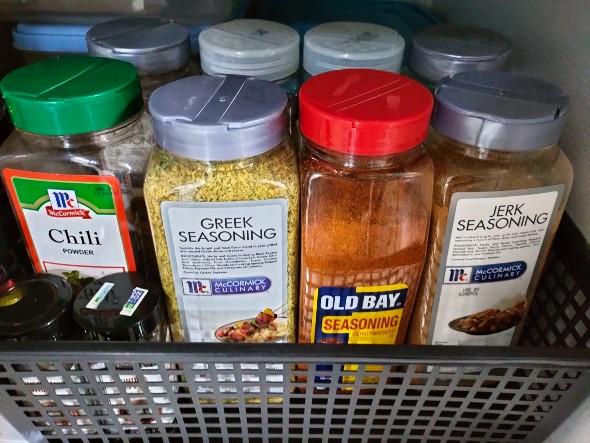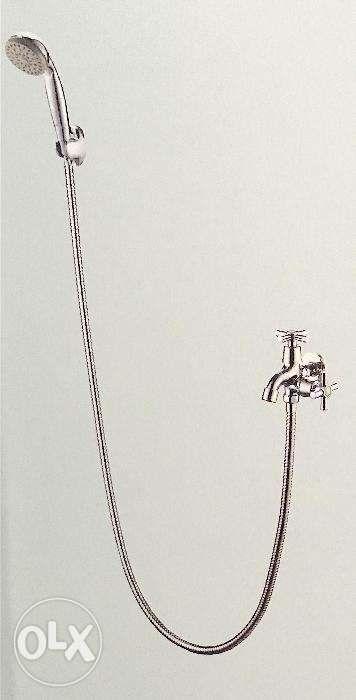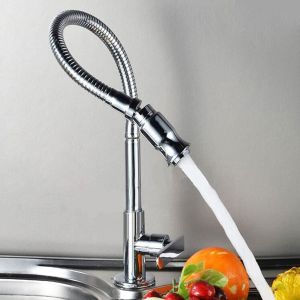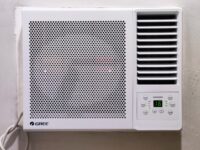It’s January. It’s the start of the year. It’s time to make sure that you are set up to thrive in the coming 11 months!
Of course, you need a base (your home) that supports you. Your home needs to be clean, organized, and not give you additional problems, worries, or extra work. It should be a good place for you to relax, work (if you work from home), and efficiently do home tasks that you need to do.
Here are my 10 Tips to Improve Your Home:
1. Make Your Bed Everyday
This just sets the day right and makes a big impact on how tidy your bedroom looks. I used to do the bed spread / comforter duvet thing but it’s not really practical and took too long because I wanted to make sure everything was even, etc… Then I asked myself why I was even doing it that way, when the way we used to do it is just to fold the blankets and pile the pillows neatly. Now I just make “pag-pag” (shake off dust) the fitted bedsheet, pillows and blanket, and then fold the blanket and neatly pile it with the pillows. Done. Everything takes less than 1 minute. No more fiddling with cover sheets or duvets, which are also a pain to launder! I gave up on them. I have a thick, white, fluffy, microfiber blanket, and that’s all I need.
Don’t feel that you have to make your bed the way the magazines do it if it’s not practical for you. Do what works for you.
2. Declutter
Not just physical clutter, but also digital clutter. If you have any negative feelings from 2020, maybe you can declutter those, too 🙂
Decluttering frees up space on our minds, in our hearts, in our house, in our digital spaces. You can sell your decluttered items if they have value, or give them away to friends who want them, or you can barter them for something you need. You can also donate them to places that need them – there were many people affected by fires, floods and other calamities last year.
Let them go so that you’ll have the space to accept better things and positive energy in 2021!
3. Give everything its own space & clean up as soon as you can
As much as possible, things in your home must have designated spots where they are kept, and label them as much as is practical. This way, you’ll always know where to find them, and where to put them back. Other people will also know to do this if the spaces are properly labeled.
When you take things out, make the effort to put them back. It’s easier to put things back right away. Don’t wait until everything is a big mess before tidying up when it is going to look like a daunting task.
I always place a duster or a microfiber cloth in every area (bedroom, living room, office, kitchen, bathroom, etc..) where it’s not so visible, but still easily accessible, so whenever I see something dusty or dirty, I can quickly grab the duster or cloth and take a few seconds to dust the thing that’s dusty. It literally takes less than 1 minute to do, and it’s easier than having to spend more time doing tedious deep cleaning because the place has gotten too dirty.
Organize Efficiently
Also, when organizing spaces, put things where you you frequently use them. Some questions to consider when choosing spaces for your items:
- Where is the first place I think of when I’m looking for this?
- When doing chores or tasks, have you ever wished that something you needed was nearby instead of far away?
For example, pot holders, frequently used cooking utensils, oils, spices and sauces should be near the stove / oven.
According to some minimalists, you should only keep one of something. I have to disagree, especially when it comes to pens or scissors. I have multiple pairs of scissors at home. At least 2 in the kitchen, one on each desk, and also one in any area where it is needed, like, I also have one by the main door to make opening packages easier (I also have a cutter there, as well as alcohol spray). I also keep a pair of scissors in the bathroom to open beauty products, cut open sachets, etc… I also keep one in my closet to make it easy to cut away loose threads / tags. I also have a pair of scissors in my sewing kit. I can’t be walking to the kitchen all the time every time I need scissors!
4. Set appointments to do things to reach your home goals
For example, my main Gmail account has so many emails and I want to clear out all the spam and unnecessary emails. I set a 15-minute appointment / task on my calendar for every Thursday to clear out as much as I can of my digital clutter. I know I won’t be able to finish all my digital decluttering, but 15 minutes of decluttering is better than none. I started out with a pile of 6,000 unread emails and right now, I’m down to 900+ after a few rounds of this. Some times I just do only 5 minutes, and some times I go for 1 hour or longer. I listen to a podcast or video update or some music while I’m decluttering my emails.
Another example is – I want to maintain a clean, tidy room. I put a repeating task on my calendar for every Saturday to dust everything in my room and to vacuum the floor. This takes less than 30 minutes (sometimes it only takes 15 minutes) because I do this every week, so it never devolves into a big mess and everything is very easy to clean – I just do one pass with a microfiber duster over everything, and my room never gets dusty enough where you can literally write things on the dust, unlike before 🙂 I also try to declutter as much as I can so there are less things to dust! For a final touch, I spray some room spray or linen spray, or clean & refill the humidifier and put a scent.
Other things that you can schedule on a recurring basis on your calendar are:
- cleaning your electric fans (make sure they are unplugged before disassembling the fan)
- cleaning the aircon filters (ideally weekly, but it depends on how dusty your environment is)
- having the aircon professionally cleaned (you need to do this every few months, depending on how dirty your area is)
- cleaning gutters & drains, especially if you have trees in the area whose leaves can clog up the gutters & drains, preferably do this before rainy season starts; while you’re at it, check if there are areas on the roof that need repair
- cleaning your washing machine (we usually leave the washing machine door open to let it air out after use, so it doesn’t get moldy at all, and we don’t need to clean it so often)
- cleaning outdoor spaces (outdoor floors & walls tend to get very dirty or have some moss growth, the easiest way to clean them is through power washing, do this when there is an abundance of water and not during water shortage months)
- other home maintenance activities (cleaning windows, ceilings, etc…)
5. Meal Plan
Does thinking about what to cook every day make you want to pull your hair out? Me, too! I have been meal planning on and off for a few years now, but now I’ve been doing something like a Korean method that I picked up while watching k-drama – I make banchan!
After groceries, I don’t just chuck everything in the freezer / refrigerator anymore. Instead, I clean & prepare the food as much as I can. The work is front-loaded on the weekend, so the rest of the week becomes easier.
We do groceries on either Saturday or Sunday, so, before the meats are frozen or before the vegetables wilt, I do these:
- rinse, chop & marinate the meat – this way, you don’t waste time & effort freezing the meat right after grocery, then thawing the meat, then marinating it – just marinate it right away and only thaw it one time. Once the meat is thawed, it is ready to cook. Bonus: the flavor gets in the meat better this way.
- start cooking the vegetables / side dishes I can pre-cook – make banchan! There are many banchan recipes available online. I make a few of the following: braised potatoes, braised peanuts, sautéed radish & carrots with dried seafood, honeyed squash, candied sweet potatoes, bean sprouts, eggplant fritters, fried tofu, soy garlic spinach, soy garlic kangkong, sauteed pechay, little okonomiyaki pancakes, gyeran mari (egg roll), japchae, garlic peanut noodles, etc.., all depending on whatever’s on sale / available / in season. They keep in the refrigerator for about a week (or longer). I just reuse those plastic takeout containers we get from food delivery. Then, during meal time, I just transfer a meal size portion to a serving plate. Some of the food need to be reheated either in a pan, the microwave, or the air fryer, but for the leafy vegetables, I take them out early so they reach room temp by meal time. I notice that reheating them makes them less fresh looking. This way, I don’t have to worry so much about the side dishes I need to serve during the week’s meals – they’re all ready. I can just mix and match side dishes and not serve the same things two meals in a row. The family also gets to eat a good variety of food during each meal, with a varied source of nutrients, vitamins, trace minerals, with different colors so it’s not boring – there’s meat, seafood, eggs, green leafy vegetables, root crops, etc…
- par-boil vegetables I won’t be able to cook immediately – kangkong, spinach and other leafy vegetables, broccoli and cauliflower, wilt pretty fast, so I have them cleaned as soon as possible, and stop the wilting process by cooking them in salted boiling water for about 20 seconds up to a few minutes, depending on the vegetable. These last in the refrigerator for about a week if kept in a closed container with a draining tray. They are ready to be added to stir-fries, soups, noodles, or just plainly tossed with fresh fried garlic oil, soy sauce or any sauce of choice (lately, we’ve been loving wasabi mayo).
Even if you are ordering out often, it makes sense to make a plan, too, so you won’t feel so lost and panicky before every meal time. My meal plans are flexible – meals can be moved to other days in case we suddenly want to have take out instead.
Also, if you have a meal plan, you’ll know what you will be cooking the next day. I often prepare things the night before – meat that needs to be defrosted for tomorrow are already taken down to the ref from the freezer, beans that need to be soaked are soaked (ex. monggo). For dishes that can be scheduled to cook in the Instant Pot like stews, etc.., I already cook it in the Instant Pot (saute the aromatics, brown the meat, then put everything else except finishing herbs like green onions or malunggay), then set a timer to start cooking at around 9am or 10am for lunch. There’s a Keep Warm function so it’s better that the food is ready early rather than late. If you are cooking for a family, a cooking appliance that you can schedule & program to cook is a sanity-saver, especially if you are not a morning person and must have lunch ready by 11:30am! 😀
6. Pre-Chop Some Garlic!
We use a lot of garlic for cooking, and having to peel and chop garlic every time is just not efficient, especially when you have to do this for almost every single meal. So whenever I don’t feel like doing anything but sit in front of the TV, I set up a garlic peeling station in front of the TV (or on our outdoor table), and I proceed to crush & peel A LOT of garlic. I usually choose easy-to-follow movies that I don’t need to pay too much attention to – no need to read subtitles nor have to analyze complicated plots.
And then I run the peeled garlic through a food processor, and shape them into squares to freeze. I just use some plastic for this, shape the garlic flat, then score with the dull edge of a butter knife to make the squares. You can also use designated ice cube trays instead, don’t use your regular ice cube trays or they’ll smell like garlic. Once the garlic is frozen, I transfer the garlic squares to a container and put it in the freezer. All good for a month’s use. Every time I need garlic, I just get squares of pre-chopped garlic – so easy! No more wasting time peeling & chopping every single time I need garlic.
Unfortunately, this doesn’t work with onions, but at least, onions are easier & faster to chop.
7. Stick to a Color Scheme When Buying Things for Your Home
It’s taken me a while to realize what made our house look cluttered and not cohesive. Aside from the obvious clutter, it was the mish-mash of colors of the items, too, i.e. visual clutter. We had plastic baskets and containers in all colors – aqua, blue, orange, yellow, red, green, gray, black – that were bought because the colors looked nice at the time, with no thought to whether they will fit in the interiors. It looked crazy and hurts the eyes.
So after we did our renovations last year, repainted our walls, etc… our things still looked cluttered. Since then, I have been slowly replacing those colored baskets with new baskets that fit in with our interior’s theme. Our color theme is white and natural colors like wood, with accents of green. I have laid down the law at home ? everybody knows that they cannot buy anything with colors that don’t match our home. Plastic baskets? Buy only white / transparent. Tabo? White. Electric fan? White!!! White electric fans are so hard to find!!! Rice cooker? White. Dustpan? White. Mop? White. If all white isn’t available, we choose the closest color – usually light gray. Shelves? White, wood or black, but white is preferred. You get the picture 🙂
If we can’t find it in white, I tell them not to buy it. It’s a waste of money if we end up having to replace it because it is an eyesore. If we really, really need it and really can’t find it in the acceptable colors, we paint it white. For things where we don’t have much of a choice like for some appliances, we just stick with the basic black or silver metallic.
The process is still ongoing and we still have a lot of things that need to be replaced, but things look so much better, more cohesive, and more relaxing. Even if everything is from different brands, they all look harmonious because they are within a color scheme. For 2021, think about your preferred home color scheme and work your way towards achieving it little by little 🙂
8. Play Some House Music + Consider Using Wifi Speakers
Aside from scent, another thing that identifies a space is music. It’s why coffee shops always play some café jazz – as soon as you hear the music and smell the aroma of brewing coffee, you just feel it in your bones – your body identifies the place and your mood changes to match (hopefully it puts you in a positive mood).
You can play any music that you like for your home. It’s just that having pleasant background music gives a good ambience and helps improve people’s moods, too.
You can use any speaker you like for this. Personally, I prefer using a few Google Home Minis / Google Nest (they are getting more affordable) around the house. What’s the difference? For one, I can order around the Google Minis by voice. They can also play the same music synced across all the Google Minis. So, for example, if your house has 4 floors, and you have a Google Mini on each floor, you can play the same thing on all the 4 Google Minis, synced. This means you’ll hear the same music throughout all the 4 floors. This works great if you are having, say, a Christmas party at home – Christmas music will be playing throughout the whole house.
You also don’t need to bring your portable Bluetooth speaker with you if you’re moving from the 1st floor to the 4th floor, for example, like if you have to hang the laundry on the 4th floor or something. If you are only playing music on the speaker on the 1st floor and you’re moving to the 4th floor, you can just tell Google to transfer the music to the 4th floor speaker.
You can also use the speakers as a walkie-talkie. You can use the “Broadcast” command to announce to all the speakers that dinner is ready, for example 🙂 Google records your voice message and blasts it on all the Google devices. No need to type anything. Then everybody at home who is within earshot of a Google speaker should hear that dinner is ready. This also works, for example, when one is on the way home from grocery shopping. On your mobile phone connected to mobile data, you can tell Google to Broadcast “I’m on my way home, I’m 5 minutes away, get ready to open the gate and bring up and sanitize the groceries“. People can also Reply to Broadcasts on their Google devices.
With all that being said about Google speakers, they are not the brightest. They usually give me the “I’m sorry, I don’t understand” response to many commands, so I usually just stick to the most common commands like “Play music,” and “set a timer / alarm” when I’m cooking, or “Remind me to …” . For more complicated commands, I create Google Home routines.
For example, I have a routine to play certain playlists:
- “Hey Google, make it sound like Christmas” plays my specified Christmas Jazz playlist on Spotify.
- “Hey Google, I’m feeling like Korean today” plays my specified K-drama OST playlist on Spotify.
- “Hey Google, play some house music” plays my specified coffeehouse playlist on Spotify.
If you have a predictable routine, you can just set up the music to play at certain times.
For background house music that sounds like your favorite coffee shop’s, I recommend checking out the Cafe Music BGM Channel offerings. They are free to listen to on Spotify (with ads on free account, ad-free on upgraded Spotify account).
Other advantages: When I’m watching K-drama, for example, and a character was offered 10 million won to do something, I have no idea how much 10 million won is, so I ask Google “How much is 10 million won in pesos” and it tells me.
The Google Home devices do have a lot of advantages, but there’s also a privacy issue since they seem to be listening all the time. It’s up to you to decide. Personally, I just put them in common areas and not in private spaces.
9. Think of Feasible Ways to Make Your House “Smart”
If you want to go a bit further, you can make some home appliances “smart”. I haven’t gotten round to this yet. My next project is to buy smart plugs (I saw one for about P200+ on Shopee) for our patio string lights so they will automatically turn on at 7pm and turn off at 5am.
I already bought some solar string lights, and these work great to light up a dark part of the other side of the house. The solar string lights were around P300+ each. I hung them up on the roof gutter with some gutter hooks (bought from Shopee). They are not very bright, but they still provide light to make the area less scary and more positive feeling (good chi). The solar panels are rested on the roof to get maximum sunlight. This way, the lights automatically turn on when it gets dark and turn off in the morning, the lights lasts until 5 or 6am in twinkling mode! Since they are automatic and outdoor-safe, I never have to worry about plugging and unplugging them every day.
However, for the part of the patio where we stay at more often, I wanted the light to be brighter, so I still chose to use an electric string light. The light is still plugged in manually every night, and it’s a bit of a hassle, so I’m going to be buying a smart plug for it to turn it into a “smart” light so I can program it to turn on and off at certain times via the Google Home app.
I also strung some lights on our outdoor stairs so that people who come home at night won’t be greeted by a dark entrance. I can’t do solar lights here because the area is covered by an extended roof and doesn’t get direct sunlight. So the light I used here is also electric, and I plan to get a smart plug for this as well.
It’s not like we don’t have any outdoor lights built in to the house, it’s just that for the “real” outdoor lights that we have, we used very bright daylight white light bulbs for them. These are used when we have things to do at night (task lighting). But we can’t keep them on all the time, and when they are turned off, the house looks very dark from outside. This is why I added these string lights (all in warm white) to provide soft warm lighting all through the night with very low energy consumption (or free, in the case of the solar string lights).
I also put up more string lights indoors to serve as “night lights”. I plan to make them smart, too, so they automatically turn on after dinner and turn off at 6am. This way, the house is lit all night with a warm glow and people don’t bump into things when they get up to get a glass of water or a midnight snack or something 🙂
Actually, I put up the string lights for Christmas, but quite like the cozy vibe they gave the house, so I decided to leave them up permanently.
The string lights are relatively cheap, ranging from P100 to a few hundred pesos only, and they are easy to hang up or replace when they wear out eventually. At first, I was seriously considering using LED strips, but after watching a few how-to videos, they seem complicated to install properly, having to buy connectors and LED channels, etc… String lights just seemed simpler 🙂 I was also thinking of using smart bulbs, but I didn’t want to replace all our existing light bulbs (too many, too expensive), nor did I want to add any floor or desk lamps that the cats will just end up breaking.
For now, the string lights work and I’m satisfied with the cozy ambience they provide the house at night 🙂
Speaking of “smart” appliances, an Instant Pot or an air fryer aren’t exactly smart, but they really do help a lot in terms of minimizing cooking work.
With the Instant Pot (or other digital pressure cooker), you can put the food in, close the lid, and set the timer delay to start cooking, say, 6 hours from now, and to cook for 45 minutes. You can pressure cook, steam, slow cook, etc… If you put the cooking time correctly, it should not result in burnt food. It will turn off automatically when finished. Instead, the food will be perfectly cooked and kept warm. I use the Instant Pot primarily for soups and stews and meat dishes that need tenderizing.
The air fryer can cook anything that is not “wet”. We use it to heat / toast food almost every day, this has replaced our oven toaster. As in! Aside from cooking frozen french fries, chicken nuggets, etc… I have also cooked chicken wings, a whole turbo chicken, “fried” fish, boneless bangus, etc… even tonkatsu, chicken karaage and chicken satay! The trick is to use enough oil to make sure that each piece is fully coated in a light layer of oil. You can use an oil spray for this (spray generously on both sides), or add a few tablespoons of oil to the marinade, or brush the meat with oil. Make sure all the “breading” has some oil, any un-oiled breading will result in a floury-tasting breading when cooked. This still uses less oil than conventional frying methods. Another plus? No oil splatters!!! You get fried results without any pain or oily stove cleanup. Did you know that you can even bake small cakes & cookies in the air fryer? You can! Air fryers also have a timer, so as long as you set it correctly, your food will not burn because the air fryer will stop cooking when the timer is done.
This is our favorite, easy to cook, flavorful chicken using McCormick Jerk Seasoning. The marinade is just the McCormick Jerk Seasoning, apple cider vinegar, some salt, and olive oil (adapted from this recipe). Lately, we’ve also been loving the McCormick Greek Seasoning for chicken, almost same marinade as this one except using Greek Seasoning.
We use our Instant Pot at least 3x a week, and our air fryer every day. They are honestly life-changing and have made kitchen life so much easier. Some food still needs to be cooked in regular pans (I have not tried cooking lumpiang shanghai in the air fryer), but the load has been lightened considerably.
10. Install More Useful Faucets Where Needed
Some things are just easier to wash with a flexible faucet. If you have basic plumbing skills, you can buy faucets with a telephone showerhead attachment (or you can use a bidet-like contraption) and replace the faucets where you need this kind of flexibility. These range from P100+ to a few hundred pesos at hardware stores (I see a lot at Ace Hardware). Check pipe size measurements to make sure you’re buying the correct size for what you need. If you’re not sure, it’s better to hire a plumber to do the replacement.
Something like this, but choose the style you like, or choose a shorter one, just make sure the knobs are easy to open and close.
For us, we have replaced the faucet in the dirty kitchen with this kind of faucet. We chose a plastic all-white one just so it won’t look like a bathroom. The normal faucet is for regular use, and the telephone type showerhead is to make it easier to rinse bigger items like dirty laundry baskets, dirty electric fan grates, bigger pots, etc… I insisted on this replacement because I used to get splashed by soap and water A LOT whenever I’m washing those things with a tabo or trying to move them back and forth under the fixed faucet ?
For places where the telephone shower extension won’t look nice (like the kitchen), I got a flexible gooseneck faucet that we can move around. Something like this:
Also, for bathroom sinks with the standard tiny faucet that is so short that it’s difficult to use, we replaced it with gooseneck faucets as well with easy open levers instead of difficult to open knobs. Prices start at a few hundred pesos up to a few thousand pesos for the good quality stainless ones.
There is a nicer kind of faucet where you can pull the faucet head and it becomes like a hose, but it’s expensive (a few thousand pesos, at least, and above P10,000 for the really nice one), and I’ve only seen a few models available, it’s actually kind of rare because it’s expensive, I think I’ve only seen it at the big Wilcon branches or at MC Home Depot.
I hope these tips will help you have a better home for 2021 🙂
Do you have some tips you’d like to share? Please share them in the comments below! 🙂
